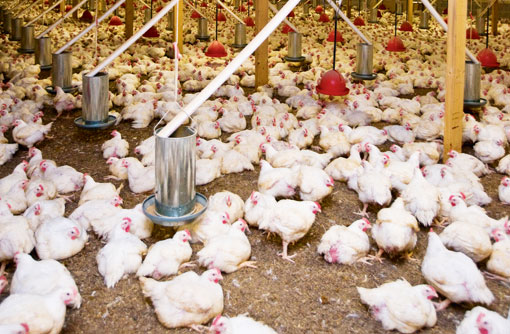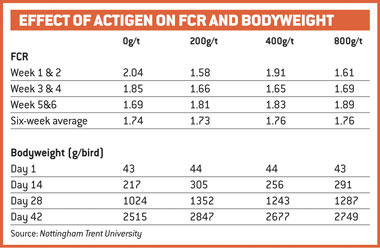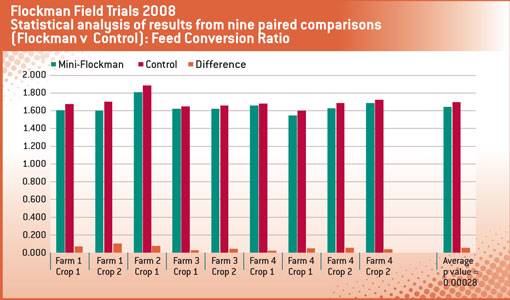Feeding for better broilers

Feeding was to the fore at the World Poultry Science Association meeting earlier this year. Philip Clarke takes a second look at some of the papers.
Feed additives play an important role in boosting the performance and welfare of broilers, especially since the EU banned the routine use of in-feed antibiotics.
Work by Nottingham Trent University, in association with feed additive company Alltech, showed that mannan oligosaccharides (MOS) could lead to improved feed conversion and greater body weight.
Feed additive Actigen – a carbohydrate fraction isolated from MOS – was used in the research, to investigate the impact on performance and gut development of broilers.
The study involved taking 240 Ross 308 chicks and feeding them a wheat/soya bean meal diet with three different concentrations of Actigen from 0 to 42 days of age.
 “Bird performance was evaluated by measuring live weights, feed intakes and feed conversion ratio on a weekly basis,” explained lead researcher Harriet Lea, at the World Poultry Science Association meeting. “On day 42, the gastrointestinal tract was taken and the weight of the duodenum, jejunum and ileum measured.”
“Bird performance was evaluated by measuring live weights, feed intakes and feed conversion ratio on a weekly basis,” explained lead researcher Harriet Lea, at the World Poultry Science Association meeting. “On day 42, the gastrointestinal tract was taken and the weight of the duodenum, jejunum and ileum measured.”
The results showed that, in the first four weeks of life, the inclusion of Actigen significantly improved FCR, though in weeks five and six the birds fed the control diet caught up, (see table, left).
In terms of average body weight, all birds fed Actigen weighed more at 42 days, while in terms of gut development, the researchers found the gastrointestinal tract weighed less in the birds fed the supplement.
“These data show Actigen to have a positive effect on broiler performance,” said Ms Lea. The effects may be age dependent, she added, with younger birds responding more than older ones, possibly due to the more transient and less mature nature of the gut microflora.
Silicon supplements
Another paper from Nottingham Trent looked at the effect of including dietary silicon in order to reduce lameness.
“Silicon is thought to be essential in bone health and formation,” the paper says, “but studies using silicon supplements have been varied.”
But researches at Nottingham have developed a novel form of silicon with potentially high bioavailability, and two studies were undertaken, feeding different amounts to Ross 308 chicks.
Analysis of the first trial showed that birds fed the highest level of silica had a significantly lower incidence of lameness than the control birds. And analysis of birds in the second trial showed that over 95% of the silicon made available had been digested.
The report concludes: “Overall, it may be concluded that this novel form of silicon supplement has high bioavailability, but larger scale studies are needed to substantiate its potential role as a commercial supplement for reducing lameness in broilers.”
Flockman system
Field trials have shown that restricting access to feed to certain times of the day can lead to improved feed efficiency and better margins.
“Modern chickens are descended from the dinosaurs, which also had crops and gizzards,” poultry nutritionist David Filmer told the meeting. “Evolution has had plenty of time to perfect them and they are an important part of the digestive system.”
Mr Filmer explained that modern broiler production had led to many changes in the lifestyle of the birds. In particular, ad lib feeding and the removal of whole grains in the rations had led to inactive crops, incomplete digestion and poorer feed efficiency. “My work has been to reverse these penalties,” he said.
Field trials in 2008 had involved nine pairs of broiler houses with at least 25,000 birds in each, fed on standard commercial feeds. The control house in each pairing had ad lib feed, while the other house was restricted to specific meal times.
“Birds on the new system had significantly less mortality, faster growth and better feed efficiency,” said Mr Filmer. “They were also visually cleaner and more active.” (See graph, below)
The explanation lay in the fact that the restricted regime was more akin to natural feeding conditions. With limited access to food, the birds ate more quickly, filling their crops. The feed then became soaked, swelling and softening before entering the gizzard and the rest of the digestive system.
“Food with a porridge-like consistency is optimal,” said Mr Filmer.
The observations led him to develop the Flockman system, in which feed is made available in several distinct meals, with the pans allowed to empty for several hours at a time. As well as increasing the birds’ appetite and encouraging full crops, it also ensures that feed is never left to go stale.

